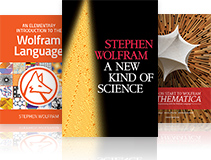How High School Students Discovered New Formulas Using Mathematica
Ryohei Miyadera, Shunsuke Nakamura, Yu Okada, Ryo Hanafusa
Published December 26, 2013
This article presents the results of high school mathematics research projects. The authors are Dr. Miyadera and four high school students. Under the leadership of Dr. Miyadera, students have been doing mathematical research using Mathematica for more than 15 years, and they have discovered many formulas and theorems. They have given talks at conferences and published their results in mathematics magazines. In this article the authors present the results of the research on chocolate games, which are variants of the game of Nim. That high school students can discover new theorems and formulas with Mathematica is very important for mathematics education. The authors think that the best way to learn how to be creative is to make something new. The combination of Mathematica and the fresh minds of high school students can produce remarkable results. Read More »
Todd D. Allen
Published November 26, 2013
This article describes the development of a novel program to process Affymetrix microarray files, which are used in the biological sciences to establish differences in gene expression between two conditions (e.g., diseased tissue versus healthy tissue). Read More »
Robert Cowen
Published October 21, 2013
Using some examples from Ramsey theory, this article shows how to use Mathematica‘s Boolean computational capability. Read More »
Todd Silvestri
Published September 24, 2013
N. D. Bagis
Published August 26, 2013
Michael L. Zwilling
Published June 27, 2013
Negative binomial regression is implemented using maximum likelihood estimation. The traditional model and the rate model with offset are demonstrated, along with regression diagnostics. Read More »
Yasushi Miki
Published May 27, 2013
This article presents a mathematical model for generating annoying scratching sounds. Such sounds are generated by frictional motion and have been attributed to the chaotic nature of the frequency spectrum thereby produced. The proposed model is based on the logistic map and is modified to have the stick-slip property of a frictional vibration. The resulting sound is similar to that generated by scratching a chalkboard or glass plate with the fingernails. Read More »
Chapter 9
Programming with Mathematica: An Introduction
Paul Wellin
Published April 30, 2013
This article is an excerpt from the recently released book, Programming with Mathematica: An Introduction by Paul Wellin © 2013 [1]. The book, which follows on the well-known An Introduction to Mathematica Programming, provides an example-driven primer on the foundations of the Mathematica programming language.
Strings are used across many disciplines to represent filenames, data, and other objects: linguists working with text data study representation, classification, and patterns involved in audio and text usage; biologists dealing with genomic data as strings are interested in sequence structure and assembly and perform extensive statistical analysis of their data; programmers operate on string data for such tasks as text search, file manipulation, and text processing. Strings are so ubiquitous that almost every modern programming language has a string datatype and dozens of functions for operating on and with strings. Read More »
Denis Cousineau
Published March 20, 2013
The NXT is a general-purpose processor that can be used to control motors and sensors; it is ideal for building autonomous robots. It can also communicate with more elaborate software located on a computer, using a Bluetooth communication port. In this article, we show how to communicate with the NXT by sending the correct bytes. We also introduce a package that manages all the exchanges through functions. These functions can be used in conjunction with dynamic cells to display the robot’s status and control the robot’s motor. Read More »






